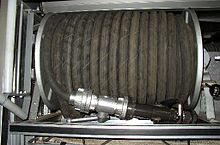Rapid attack device
The rapid attack device , rapid attack device or device for the rapid delivery of water can be found in the fire brigade on fire trucks and fire fighting vehicles .
It consists of the water tank built into the vehicle , a pump and a pressure hose connected directly to the pump with a multi-purpose or hollow jet pipe , which is rolled up on a reel in the rear of the vehicle. It is usually braked pneumatically and can be pulled off freely when the brake is released. The hose is rolled up either by hand or with a small electric motor.
A special form of the rapid attack device is the high pressure rapid attack .
The rapid action device is mainly reserved for the dimensionally stable pressure hoses . The length is between 20 and 90 m.
Use in action
The rapid attack device offers advantages for smaller extinguishing operations such as car fires , container fires , etc., as it is immediately ready for use. It is unsuitable for building fires or major fires for several reasons:
- The hose is relatively short. As a rule, this can be extended with normal hoses, but then the main advantage of the rapid attack is gone and a regular hose line can also be laid directly.
- The mostly dimensionally stable hoses are rubberized on the outside and are difficult to pull around corners, for example. This is particularly problematic in an internal attack .
- Even before a dimensionally stable hose is filled with water, its weight is relatively high compared to normal roller hoses.
- Dimensionally stable hoses have a significantly smaller cross-section than normal roller hoses. As a result, not only is the maximum possible volume flow lower, but the pressure loss is also significantly higher.
Since then it has come during the use of fast attack hoses for firefighters inside attack to severe, sometimes fatal accidents, one has come to the fire station to realize the inherent protection to dispense with internal attacks on the fast attack hose.
Pump & Roll
Pump & Roll describes extinguishing while driving. The rapid attack device is often used for this purpose. To do this, the hose is unrolled about 5 m and guided by two fire brigade members. With the pump running, the (tank) fire engine drives at walking speed in the black area (= burned area) along the edge of the fire while the fire is being extinguished. This simultaneous pumping and driving is not technically possible with all fire fighting vehicles; many vehicles can only either drive or operate the vehicle pump. The use of a rapid attack device, however, proves to be disadvantageous when taking into account the possibility of retreat. In an emergency, the hose cannot be disconnected like a normal C-hose and can therefore pose a great danger.
Situation in Germany
In Germany, hoses placed in bays with a connected jet pipe also count as a so-called "device for rapid water delivery" and thus as a rapid attack device, since you only have to pull the hose out of the vehicle (this is also the case with the current fire fighting vehicle for civil protection). This has the advantage of considerable cost, weight and space savings in the structure of the vehicle, but disadvantages compared to a dimensionally stable hose, since the entire hose has to be laid before the water is dispensed. When comparing the attack speed, however, there is no significant difference, nor is there a difference when it comes to refitting the vehicle. In the event that the hose is too short, a device for rapid water delivery can be extended more easily if necessary. The disadvantage of the smaller cross section, which leads to a greater pressure loss in the hose, is also eliminated here. For these reasons, this design has been experiencing a renaissance for some time, and even professional fire departments are returning to it because of its advantages.
The current vehicle standards allow the use of the following hoses for rapid attack devices:
- 2 pressure hoses C 42-15 ( DIN 14811) or
- 2 pressure hoses D 25-15 (DIN 14811) or
- 1 dimensionally stable pressure hose DN 25 (50 meters, DIN EN 1947) or
- 1 dimensionally stable pressure hose DN 33 (30 meters, DIN EN 1947)
Older vehicles often still use the non-standardized, dimensionally stable pressure hose-S or a pressure hose C 42-30. If a high-pressure pump is installed in the vehicle, corresponding high-pressure hoses are used.
literature
- Hans Kemper: Vehicle customer, part 2 . hjr-Verlag, 3rd edition 2010. ISBN 978-3-609-62014-5
- Diverse: Hamilton - Handbook for the fire brigade . Boorberg Verlag, 21st edition 2012. ISBN 978-3-415-04560-6
- Diverse: The fire brigade textbook . Verlag W. Kohlhammer, 2nd edition 2012. ISBN 978-3-17-022518-3
Web links
Individual evidence
- ↑ Dead firefighter at cellar fire (March 6, 1996) , http://www.atemschutzunfaelle.de/
- ↑ LF-KatS fire fighting group vehicle data sheet ( memento of October 4, 2013 in the Internet Archive ) (PDF; 93 kB), Federal Office for Civil Protection and Disaster Risk Reduction
- ↑ Fire-fighting and rescue vehicle 20/12 DLS. Berlin Fire Brigade, accessed on March 28, 2020 .



